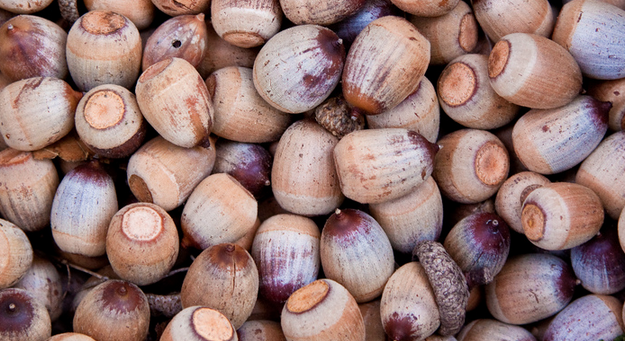ACORNS BEGINNING TO REENTER HUMAN DIETS

Photo: princedd/creative commons
Without the help of a single drop of chemical fertilizers or pesticides, our oaks dropped an incredible crop of acorns on our heads this fall. This year is what scientists call a “mast year,” when the acorns are so plentiful that the squirrels, birds, deer, and bears can all eat their fill and still leave plenty to germinate.
Until recently, humans were regular participants in the harvest. Most cultures that developed under the shade of the oaks treated acorns as an important source of nourishment for humans and livestock, including North Carolina’s Cherokee, Catawba, Saponi, Tutelo, Tuscarora and Croatan tribes. It was only with the advent of industrial agriculture that the subsidized cost of corn, wheat and soy allowed humans to forget the oak’s gift.
In the US, only a handful of indigenous tribes, immigrant communities and foragers still harvest acorns, but the acorns’ neglect may finally be coming to an end. Responding to growing demand for gluten-free flour and sustainably-grown crops, food entrepreneurs have begun developing new acorn-based products. As North Carolina’s farms shift towards sustainable practices, oak trees may well return to a place of prominence in agriculture across our state.
History of Human Acorn Use
Oaks serve as a keystone species in many bioregions, and can live well over a thousand years. Many cultures considered oaks to be sacred trees, often tending the forest to help ensure that oaks had room to thrive. Acorns are a part of food traditions all around the globe, and each culture has a distinct way of preparing them. Indigenous people of the Americas often ground acorns into flour and pressed them for oil.
Though certain varieties of oaks have acorns that are delicious right off of the tree, most are high in tannins that need to be leached before they are palatable to humans. The resulting tannin water has been used medicinally for its astringent, antimicrobial, antiviral, and anxtioxidizing properties. It is also used in tanning leather and dying fabric.
The acorn flesh is an incredible source of nutrients, containing all eight essential amino acids and high in vitamins A and C. Cold processed acorns make a gluten-free flour that is great for baking. Acorn flour is very low on the glycemic index scale, meaning it causes much less of a spike in blood-sugar than food made from corn and wheat. Though acorns from white oaks are generally better to eat raw, the higher-tannin content in acorns from the red and black oak serves as a natural preservative.
All over the world, small farmers have used acorns to fatten their pigs and goats. Jamon iberico de bellota, often considered the best ham in the world, comes from pigs allowed to roam free in oak forests. The acorn diet improves the pigs’ flavor and increases the amount of healthy fat (high in oleic acid, a monounsaturated fatty acid shown to lower LDL cholesterol and raise HDL cholesteral).
In the 1600’s, oak habitat in the US began to shrink to make room for annual crops, like corn, wheat, cotton and tobacco. Acorns disappeared from human diets, but they remained an important food source for livestock until well into the 20th century, when farm and fuel subsidies made it cheaper to fatten animals on diets of strictly corn and soybeans.
At various times in the last century, researchers have become enthusiastic about the agricultural potential of acorns. In 1929, in his seminal work on tree crops, J. Russel Smith wrote, “The genus of oak trees hold possibility, one might almost say promise, of being one of the greatest of all food and forage producers in the lands of frost. Why has it not already become a great crop? That is one of the puzzles of history, in view of its remarkable qualities.”
Writing before farmers began applying chemical fertilizers and pesticides, Smith already understood the harm that annual agriculture did to the land. When trees are cleared and the soil regularly tilled, topsoil erodes at an alarming rate. Tree crops are far more draught tolerant, and by taking in water through their roots and breathing it out through their leaves, trees actually help produce rain clouds.
To Smith, the benefits of tree crops seemed obvious, and he was confident that America would soon make the shift to more sustainable, perennial-based agriculture. Indeed, the dustbowl did momentarily lead to a renewed appreciation for trees, but the enthusiasm did not last. Agricultural chemicals and large pieces of machinery allowed farmers to obtain large yields with minimal labour, even from depleted soils. Despite Smith’s optimism, the oaks’ agricultural relevance continued to decrease.
In the mid 1980’s, David Bainbridge, a researcher at UC Davis, made a strong case for why oaks should be an indispensable part of America’s agricultural future. He estimated that an oak orchard could produce between 2,500-6,000 pounds per acre, but predicted that cultivated varieties could bring an acre’s yield closer to 10,000 pounds (corn yields tend to range between 2,500-10,000 pounds per acre as well). He called on his fellow researchers to start developing good cultivars, but again, few paid attention.
Acorn Industry Showing Signs of Life
With the looming threat of climate change and growing demand for gluten-free flour, the acorn may be poised to work itself back into human diets. Stories in the Scientific American and NPR have helped generate new interest in acorn-based foods, and food entrepreneurs are quick to respond.
A pair of sisters in Texas recently launched a business called Mighty Wild that will sell acorn-based products, sourced from American foragers. They have just completed a successful kickstarter campaign to help fund their first line of acorn crackers.
In Martinez, CA, a Korean-American has launched Sue’s Acorn Cafe & Mill, selling a variety of acorn-based baked goods, as well as her own acorn flour. South Korea is one of the few places where acorns never disappeared from the dinner table. Dotorimuk, a jelly made from acorn starch, is still a staple in South Korean cuisine. Acorns have been an important revenue source for small-scale farmers in the South Korean countryside, but in recent years, competition from China has begun to threaten the profitability of South Koreas’ domestic acorn industry. Fortunately, many consumers are willing to pay a slightly higher price for locally grown acorns.
In other regions where acorns have dropped out of human diets, there are a number of efforts to try and bring them back. A forager in Germany has developed something he calls “NewTella,” a sweet, acorn-based spread, similar to the hazelnut-based Nutella.
On the Greek island of Kea, an entrepreneurial environmentalist named Marcie Mayer created the Hamada Acorn Initiative to revive the island’s historic acorn industry. She managed to crowdfund a dehuller, hammer mill and solar dehydrator. Her initiative now buys acorns from island residents, sells the caps to German tanneries and creates a variety of its own acorn-based products. Like much of Greece, there are few economic opportunities on the island, and residents are thrilled to be able to earn a wage harvesting a naturally-abundant crop. In her TED talk, Mayer explains that she loved the ancient oaks on Kea, and realized that the only way to protect them was to help people generate revenue from them again. She now doing a third crowdfunding campaign to help her continue to developing the island’s acorn industry.
The Acorns’ Uncertain Future
It remains to be seen whether the current resurgence of interest in acorns leads to wide-spread reintroduction of the acorn into human diets. Like most nuts, processing acorns is labor intensive. Without certain key pieces of equipment, like a dehuller, it is unlikely that anyone will manage to earn a living wage making acorn flour. At a small scale, acorn flour is costly to produce, making acorn-based products more expensive than their wheat and corn counterparts.
Yet climate change has created a surge of interest in tree crops, since reforestation is an important way of taking carbon out of the atmosphere. Restaurants like The Perennial in San Francisco are touting the eco-friendly credentials of perennial grains. Zero Foodprint is a new credentialing organization that will work with restaurants and diners to help them reduce their ecological impact, encouraging chefs to work more with crops that are less energy-intensive to produce.
It is becoming increasingly clear that planting large areas with annuals, grown as a mono-crop, is not a sustainable way of doing agriculture. Well-managed oak savannahs could let in enough light to still grow some annuals or graze sheep, cows and goats, while also producing large amounts of acorns. In North Carolina, pasture-raised pork producers certainly make use of abundant crops of acorns, and a few resourceful farmers have sold small batches of acorn-flour at farmers’ markets, but acorn-based products have not yet shown up on grocery store shelves.
As long as government subsidies for corn, wheat and soybeans remain, it is unlikely that acorns will rise to prominence as an American food crop. However, as we try to imagine what the future of farming looks like in North Carolina, we should keep our old friend, the oak tree, in mind.
Those interested in learning how to start foraging for acorns can watch this instructional video, or attend the Piedmont Earthskills Gathering, Firefly Gathering or the South East Women’s Herbal Conference.


